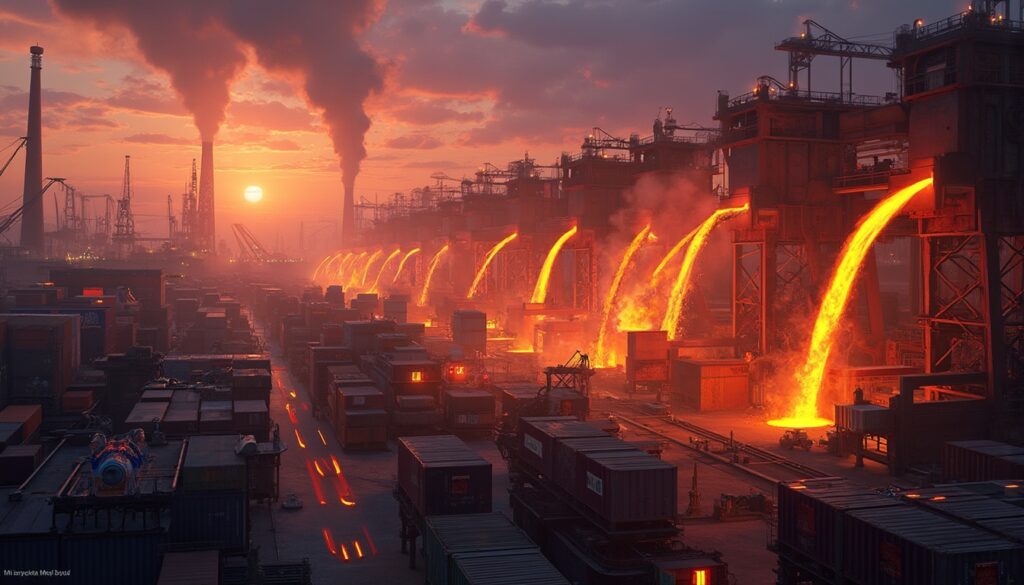The US steel tariffs of 2025 are causing dramatic shifts across domestic and global markets. The impact of US steel tariffs 2025 is evident as new measures reshape production, pricing, and supply chains. These changes coupled with geopolitical moves have forced companies to rethink strategies while governments adjust policies.
The 25% duty on steel and aluminium imports takes effect on 12 March 2025 under renewed Section 232 measures. The renewed tariffs will affect a vast range of products. In addition, trump’s trade policies impacting global commodity markets have added a political dimension to these economic actions.
Unlike the 2018 tariffs that mainly targeted China and other major steel exporters, the 2025 measures have expanded and become more complex. In this environment, the impact of US steel tariffs 2025 continues to shape the competitive landscape. Countries previously spared, like Canada and Mexico, now find themselves included.
The inclusion of Canada and Mexico marks a clear break from the integration of North American steel markets under NAFTA and USMCA. The delayed implementation until 2 April 2025 adds further uncertainty. This strategic pause gives the US leverage during upcoming renegotiations and discussions around border security.
Canadian officials and Mexican trade representatives now face the consequences of these tariffs. One distributor in the Great Lakes noted that longstanding supply chains now require complete rethinking. US companies must adjust while navigating navigating us tariff risks in the metals market to ensure continuity and minimise disruptions.
The renewed Section 232 tariffs in 2025 retain the same 25% duty level as in 2018 but leave fewer exemptions. In contrast to earlier policies that granted carve-outs to allies such as South Korea and the European Union, the new approach uses tariffs as leverage. This change sends a clear signal that trade is now tools for broader diplomatic negotiations.
In addition to Section 232 measures, a 20% tariff on a wide range of Chinese goods is imposed. When combined with Section 301 tariffs, some Chinese products face effective duties over 50%. This tariff stacking has significant knock-on effects, increasing costs for American manufacturers significantly.
Industry experts explain that the timing of these measures, implemented during relatively stable domestic steel production, suggests political motives. With domestic hot-rolled coil (HRC) prices expected to rise by 28-35% within six months, companies are bracing for further price hikes. Analysts also point to the impact of similar measures in previous years when forecasting these changes.
The economic environment remains uncertain and volatile. As the US adjusts its policies, global responses are accelerating. The European Union is reassessing its trade policies, with one eu press release on trade highlighting ongoing discussions on trade measures that could counter the US approach.
Recent policy shifts are not affecting only the US. Global trade flows are abruptly changing. Increased exports to Southeast Asia and the European Union have led to temporary declines in local prices. Markets across the world await further adjustments as global steel producers adjust their strategies.
The ripple effects of these policies are visible in the mining and finance sectors. Financial experts now analyse trends using market forecasts such as 2025 mining and finance predictions. Higher input costs and volatile pricing are raising concerns, particularly for manufacturers who depend on international steel imports.
In North America, US-Canada-Mexico steel trade has historically been robust. However, the new tariffs have strained these long-standing partnerships. Canada initially threatened retaliatory tariffs on US electricity exports but soon retracted them. Nevertheless, the damage to business confidence is already evident.
For manufacturers, these changes come with a host of operational challenges. Supply chains that once operated seamlessly across borders are now under severe strain. Trust and reliability in cross-border trade have been compromised. The threat of discontinuity forces many companies to reconfigure their supply dependencies urgently.
The multi-layered approach taken by the US government has introduced additional tariffs beyond the headline Section 232. For instance, the 20% charge on Chinese goods exacerbates the challenges for importers. Furthermore, additional reciprocal tariffs on products from nations with high average tariffs add another layer of complexity.
Some of the heightened measures include potential tariffs on finished goods, such as automotive components and computer chips. This development is already frustrating both domestic and international market players. The semiconductor industry has warned that delays in capital investments could span 12-18 months if further tariffs are implemented.
Historically, similar measures in 2018 led to rapid stockpiling of steel. Today, distributors in the Midwest are reporting 37% inventory spikes as they brace for higher costs. Meanwhile, service centres and automotive suppliers are actively managing their exposures. In response, many have started sourcing alternatives to mitigate the immediate effects of the tariffs.
Price volatility has become severe. Daily fluctuations in hot-rolled coil prices have nearly tripled compared to 2024 averages. This unpredictability has prompted distributors to shorten price guarantees to an average of seven days. Furthermore, some have modified contractual terms to include tariff-escalation and force majeure clauses.
Supply chain adjustments now form a critical part of every organisation’s risk management strategy. Approximately 14% of automotive suppliers have already shifted orders to US mills. However, domestic capacity is stretched, and delivery lead times have increased significantly. These challenges underscore the ongoing impact of US steel tariffs 2025.
Another major factor is the evolving scrap market. Prices for steel scrap have surged due to higher demand from producers anticipating tariff impacts. No1 busheling prices have increased by around 22% year-over-year. This phenomenon has led many mini-mills to adopt more aggressive pricing strategies to capitalise on increased margins.
Price impacts are not uniform across all steel products. Commodity grades of hot-rolled coil saw spot prices increase 15% in just three weeks. Estimates suggest an additional 13-20% rise in the next six months. In certain specialised markets, where domestic production is limited, price increases have been even more pronounced.
Current market scenarios pose several questions:
What price adjustments are most likely to persist?
• HRC prices could rise above $1,100/ton by Q3 2025.
• Price spreads between domestic and imported steel may exceed $200/ton.
• Specialty products might experience even sharper increases due to supply shortages.
How will manufacturers mitigate these costs?
• Many are turning to diversified sourcing strategies.
• Hedging using futures contracts has grown in popularity.
• Contract structuring now often includes clauses to cover tariff escalations.
Global steel markets are also reacting swiftly. Chinese steel exports, once intended for the American market, are now redirected to Southeast Asia and the European Union. Increased supply in these regions has driven local hot-rolled coil prices down. This shift reinforces the view that the impact of US steel tariffs 2025 is creating long-term regional disruptions.
Retaliatory measures from affected countries are not limited to steel exports. Canadian trade officials once hinted at tariffs on US electricity, and Mexican authorities are considering measures affecting agricultural goods. These developments illustrate the potential for tariffs to trigger broader economic conflicts beyond the steel industry.
Economic implications for US manufacturing are significant. Primary steel producers stand to benefit, but downstream manufacturers such as autos and construction face rising component costs. One study finds an increase of $450-$600 per vehicle for automotive components. Construction projects are similarly pressured by a 4-6% rise in structural steel packages.
Employment figures indicate a split. While the American Iron and Steel Institute predicts an increase of 5,000-7,000 new production jobs, other sectors could lose up to 34,000 jobs if the tariffs remain active. This 5:1 disparity poses challenges to the overall competitiveness of US manufacturing.
Long-term investment plans are increasingly affected. A survey shows 72% of OEMs have delayed capital expenditures due to unresolved tariff risks. Investor confidence has also taken a hit, with foreign direct investment in US manufacturing falling by 18% in early 2025. These trends highlight the pervasive uncertainty in trade policy and its cascading impact.
Legal and policy challenges continue to loom over the tariff framework. WTO compliance and domestic legal challenges add further complexity. Analysts are sceptical about the long-term sustainability of policies that expand tariff coverage beyond traditional trade issues. Questions remain over the appropriateness of linking tariffs with non-trade concerns, such as immigration and border security.
Legal experts warn that the current approach might be challenged in both domestic and international courts. The expanded scope of these measures has already prompted talk of constitutional challenges in the United States. As one international trade attorney noted, this novel linkage “will almost certainly face successful legal challenges,” thereby prolonging uncertainty.
Businesses, however, are already adapting. To navigate the uncertain tariff environment, several key strategies have been adopted:
- Diversify sourcing options to ensure uninterrupted production.
- Increase reliance on financial instruments such as futures contracts to hedge against price volatility.
- Restructure contracts to include clauses for tariff adjustments and broader force majeure triggers.
Some manufacturers are even exploring vertical integration. These new arrangements, sometimes referred to as global commodities market insights, help balance domestic production with international sourcing risks. Similarly, companies in the mining sector are watching trends closely. Forecasts like iron ore price forecast and its impact on mining provide further critical insights.
A Reuters analysis offers a detailed look at how these policy shifts influence global markets. The report, titled trump tariffs detailed report, outlines the broader implications of the tariff structure for international trade.
The cumulative effect of these policies is profound. The impact of US steel tariffs 2025 reverberates through every level of the supply chain, from primary production to finished goods. Stakeholders across the board must now prepare for a prolonged period of adjustment and realignment.
As the situation evolves, businesses remain hopeful that adaptive strategies and improved policy clarity will eventually stabilise the market. In the meantime, strategic planning and judicious risk management have become essential for survival in this shifting landscape.
Looking to Stay Ahead of Major Mining Discoveries?
Discovery Alert's proprietary Discovery IQ model instantly identifies significant ASX mineral discoveries, transforming complex data into actionable investment insights that could lead to substantial returns. Explore why major mineral discoveries can create exceptional market opportunities by visiting our dedicated discoveries page and begin your 30-day free trial today.




